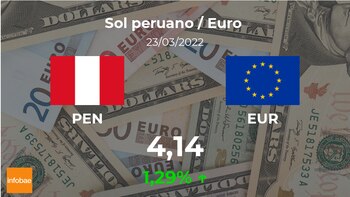
After the opening of the trading session, the euro traded at the opening at 4.14 soles on average, which implied a rise of 1.29% compared to the previous day's price, when it ended with 4.09 soles on average.
In the last week, the euro accumulated a rise of 3.48%; despite this for a year it has still maintained a decrease of 10.89%. In relation to the variations of this day compared to past days, it adds three successive sessions of earnings. As for the volatility of recent dates, it presents a balance that is visibly lower than the volatility reflected in last year's figures, so it is performing more stable than expected in recent times.
In the annual photo, the euro has reached a maximum of 4.52 soles on average, while its lowest level has been 3.97 soles on average. The euro is positioned closer to its low than its maximum.
An unstable Peruvian sun
The sun has been the legal tender in Peru since 1991 and replaced the inti, which circulated between 1985 and 1991. At first it was also called the “nuevo sol” to differentiate it from its predecessor, but by 2015 it is called only the sun.
The emergence of the new sun is understood after the world crisis of 1929, which led to a deep economic and exchange rate crisis in the country, as well as the creation of the Central Reserve Bank of Peru. It was during the first year of Alberto Fujimori's government that the new sun was promoted to balance hyperinflation and reorder the economy.
After it entered into force, a sol was equivalent to one million intis or a billion “old” suns; today the currency is divided into 100 cents and its issuance is regulated by the Central Reserve Bank of Peru.
At present, coins of 10, 20, 50 cents, 1, 2 and 5 soles and banknotes of 10, 20, 50, 100 and 200 soles are circulating. Before, 1-cent coins were also minted, but these were withdrawn from circulation in May 2011, while in January 2019 the 5-cent coins came out of circulation.
On the other hand, the exchange rate parity with respect to the dollar and the euro is fixed daily by the agency in charge. It should be noted that since 2014 the Peruvian currency has been in depreciation.
In the economic sector, the World Bank (WB) has predicted that by 2022 Peru will have growth of only 3.2% after it had a 13% rebound in 2021. Likewise, by 2023 it would slow down to grow by only 3 percent.
However, experts have assured that Peru could experience a deterioration in business confidence in the face of the uncertainty that exists in the policy and fiscal rules that are intended to be carried out.
Agencies
Últimas Noticias
Debanhi Escobar: they secured the motel where she was found lifeless in a cistern

The oldest person in the world died at the age of 119

Macabre find in CDMX: they left a body bagged and tied in a taxi
The eagles of America will face Manchester City in a duel of legends. Here are the details

Why is it good to bring dogs out to know the world when they are puppies




